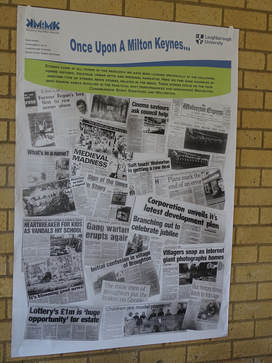|
10/21/2018 0 Comments One I have completed the first performance; it is great to get the first one done. I was unbelievably nervous. I managed to get to the venue early despite having to work in the morning (I teach three youth drama groups on a Saturday, and it must be said doing that helped to focus on their up-coming performances and reminded me what it is like to get a bit of stage fright). We set up the backdrop, organised the feedback area, lead out the welcome and further information/participation material, stashed the biscuits, milk, teas and coffees for the breakout session, and put up the media stories poster. This last part I created because when it came to including the media stories about the areas into the performance it proved difficult to translate this style of story into an oral format. I was also mindful that these stories may pertain to persons known in the area and with getting their first-hand account it would be easy to misrepresent the story. Therefore, I decided the inclusion of media stories whilst important to be recognised as a form of storytelling relating to Milton Keynes and its specific areas was probably best represented in poster form rather as an oral version.
When storytelling begins there is an acceptance of roles each party takes, whether teller or listener, and certain responsibilities that go with that, mostly obviously a teller will tell, and a listener will listen. There is also an acceptance that these roles can be played with once trust is built between teller and listener. When you have one person on their own you want to conduct the story in more of a conversational style rather than a set piece, this changes the dynamic of the teller and listener relationship, and in this context was difficult because where as a normal conversational story the pausing for listener's input can occur naturally, in this case it was set up in the space as a performance. It is also difficult because you end up making quite intense eye contact with your one audience member and it's difficult for that not to become intimidating on either side of the relationship.
Throughout the live performance I had to do a continual of process editing and creative adjustments, we started late waiting for or rather hoping for other audience members to arrive, but because I knew we only had a limited time in the space I knew I still had to finish at 3.45pm. Also one hour to tell to one person I felt was a bit long so I was assessing my audience throughout and when I felt that she was beginning to have enough I wrapped up the stories. In some ways all these challenges show how adaptable storytelling can be in the moment and sympathetic to the needs of the audience. On the other hand because it didn't run to plan, I can't help but feel slightly disappointed in my delivery and the lack of data generated from it. I never got that moment where I was really completely in the story, I was always very firmly in the room making the necessary adjustments for the situation, so while I feel like delivery of the stories was competent, I don't feel I did my best telling. That said, I received good feedback from my audience member, who in discussion after the performance, it turned out was on the committee for the Big Local venue and told me they had had similar issues with turnouts to events they have been running. Both my audience member and the manager of the Big Local both said that they had seen the information on social media and the posters as well as the flyers all around the area, so they did not feel that it was a lack of promotion that caused the low turnout. Maybe the lack of an audience in itself provides some data on the people in Conniburrow, my audience member adding that in the years she's lived there (since the 1980s) she has noticed how the population in the area has seen a decline in the number of families who live there and arise in landlords renting out property to multiple occupants who show little interest in the community. Without having engaged members of this community, it is hard to assess this statement and its effect. It was a hard first show but at least the first show is out the way and hopefully in the other venues I will have a higher turnout.
0 Comments
Leave a Reply. |
Terrie HoweySometimes known as storyteller Red Phoenix, Terrie has been a storyteller since 2004, and run her own storytelling and performing arts company since 2007. In 2016 she began a PhD in applied storytelling and heritage exploring how storytelling as heritage can impact on the sense of place experienced by residents in Milton Keynes in England. Archives
May 2019
Categories |
Search by typing & pressing enter

 RSS Feed
RSS Feed
